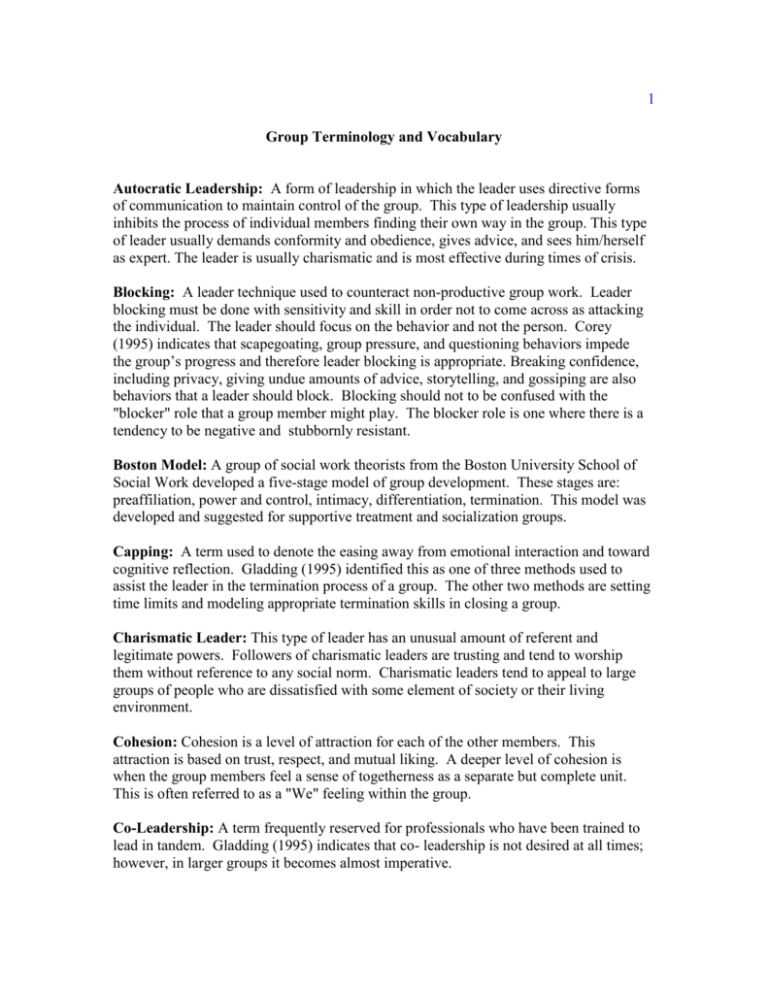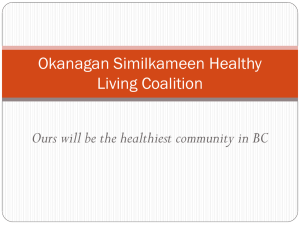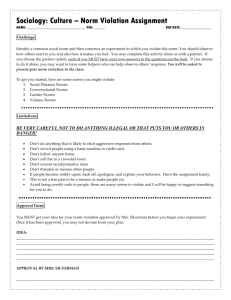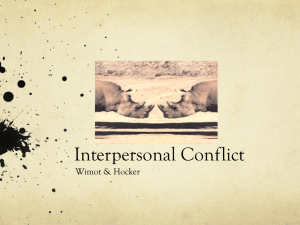Group Terminology and Vocabulary
advertisement

1 Group Terminology and Vocabulary Autocratic Leadership: A form of leadership in which the leader uses directive forms of communication to maintain control of the group. This type of leadership usually inhibits the process of individual members finding their own way in the group. This type of leader usually demands conformity and obedience, gives advice, and sees him/herself as expert. The leader is usually charismatic and is most effective during times of crisis. Blocking: A leader technique used to counteract non-productive group work. Leader blocking must be done with sensitivity and skill in order not to come across as attacking the individual. The leader should focus on the behavior and not the person. Corey (1995) indicates that scapegoating, group pressure, and questioning behaviors impede the group’s progress and therefore leader blocking is appropriate. Breaking confidence, including privacy, giving undue amounts of advice, storytelling, and gossiping are also behaviors that a leader should block. Blocking should not to be confused with the "blocker" role that a group member might play. The blocker role is one where there is a tendency to be negative and stubbornly resistant. Boston Model: A group of social work theorists from the Boston University School of Social Work developed a five-stage model of group development. These stages are: preaffiliation, power and control, intimacy, differentiation, termination. This model was developed and suggested for supportive treatment and socialization groups. Capping: A term used to denote the easing away from emotional interaction and toward cognitive reflection. Gladding (1995) identified this as one of three methods used to assist the leader in the termination process of a group. The other two methods are setting time limits and modeling appropriate termination skills in closing a group. Charismatic Leader: This type of leader has an unusual amount of referent and legitimate powers. Followers of charismatic leaders are trusting and tend to worship them without reference to any social norm. Charismatic leaders tend to appeal to large groups of people who are dissatisfied with some element of society or their living environment. Cohesion: Cohesion is a level of attraction for each of the other members. This attraction is based on trust, respect, and mutual liking. A deeper level of cohesion is when the group members feel a sense of togetherness as a separate but complete unit. This is often referred to as a "We" feeling within the group. Co-Leadership: A term frequently reserved for professionals who have been trained to lead in tandem. Gladding (1995) indicates that co- leadership is not desired at all times; however, in larger groups it becomes almost imperative. 2 Conformity: Through group there are a set of social influences that can serve to change members beliefs or actions. Higher levels of conformity usually improve the function of a group. Contagion: This is the transmission of cues by one or more group members that serve to trigger similar thoughts, feelings of behaviors in other group members. It often causes members to follow suit. Contagion has also been referred to a spontaneous pickup imitation (Redl. 1949). Critical Incidents: Gladding (1995) defines a critical incident in the group as "an event that has the power to shape or influence the group positively or negatively" (p. 448). Kottler (1994) summarized content writings of several authors who used terms such as a group problem, problem behaviors, critical issues, and critical first-time behaviors to illustrate the nature of critical incidents. Dynamics: Group dynamics is used the study of behavior in groups regarding the nature of groups and group development. It is a term to denote the interactions of individuals in a group. Emergent-Norm Theory: One of the theories to explain the Group Mind. This theory suggests that a powerful norm emerges in a group and becomes the standard for behavior. These are atypical norms, and what is conveyed is a sense of urgency transmitted through a crowd by means of mood, imagery, and actions. These moods and actions are considered right by the group, and members conform. This theory also asserts that members are highly suggestible. These are norms that become relevant at the time, based upon the makeup of the group. This type of norm emerges out of what is occurring and can be understood in terms of the Group Mind. Empowerment: Empowering an individual is to facilitate a process, the end result of which is to help the individual gain a sense of worth, confidence, and competence. Johnson and Johnson (1997) described a basic method by which an empowerment process can be launched. The idea is to allow the individual to experience the power that comes from making a choice. The group leader could facilitate this by helping members develop a variety of alternatives and flexibility in helping the client through a decisionmaking process. Encounter: Encounter is an existential term that entails a physical and psychological contact in a group context. The encounter is usually referred to as encounter experience and is of an intense nature between individuals. A result of a well facilitated encounter is a greater sensitivity and individuals gain an interpersonal intimacy with one another. Encounter groups engage members in small group experiences for the purpose of fostering personal growth through sharing sensory exploration of intrapersonal and interpersonal issues. (Eddy & Lubin, 1971, Lieberman, Yalom, and, Milea, 1973). 3 Entitativity: Campbell (as cited in Foresight, 1990) suggests it takes three components to make up a unified entity (group): common fate, similarity, and proximity. Entitativity is framed when all members experience similar outcomes behaviors and are close enough to one another to be considered as a group unit. Farewell Party Syndrome: A behavior demonstrated by some members of the group who desire to avoid what they have learned in the group. These members tend to accentuate the positive aspects of what occurred in the group. Firo: Fundamental Interpersonal Relations Orientation. William Schutz developed his instruments on the basis that people orient themselves towards people or away from them. These instruments are called the FIRO-B and the FIRO-F for behavior. Fishbowl: One method of the fishbowl is to form subgroups to monitor each other's behavior. Each member on the inside circle is matched with a member on the outside circle. The outside member will be observing to provide feedback, and conduct interchanges, serve as an auxiliary ego to his or her partner, and perform any other task so designed by the leader and members. The fishbowl is used to increase the awareness of group members to the process of the group. Group Composition: Group composition is the total sum of the group membership. Group composition will, in large part, determine the potential for positive outcome of the group process. Group Conformity: Group members exert pressure in the form of influence upon one another. This influence can be either positive or negative. In addition, group members can change opinions or decisions towards the majority. Group Dynamics: Group dynamics are the interpersonal interactions operating in a group that serve to shape the nature of that group. Group Mind: Gustave LeBon in publishing his study of The Crowd made reference to the Group Mind, which appears as the antisocial behaviors of impulsiveness, irritability, incapacity to reason, and exaggeration of sentiments. It was his opinion that members who feel anonymous and invulnerable will succumb to behavior contagions, passing emotions from one to another in a group, and are suggestible to a collective mind. There are several different theories that have attempted to explain the phenomena, such as convergence theory, emergent-norm theory, and deindividuation theory. Group Process: Group process may be thought of as the interplay of group forces or dynamics that allow the group to develope and move through specific stages of characteristically distinct types of interaction. 4 Group Themes: Cohen and Smith (1976) proposed that groups do not develope in stages as much as they deal with different themes as they progress through a process. These themes include: Anxiety, Power, Norms Relationships, Personal Growth, and Interpersonal Interaction. Group Think: A term claimed by Janis(1982) to reflect a decision-making process in which defensive avoidance is the norm. Group think is the collective striving for anonymity that overrides group members' motivation to realistically appraise alternative courses of action (Johnson & Johnson, 1997). Janis believed this type of thinking leads to mental inefficiency and ignoring of external information inconsistent with the favored course of action. Janis used the Bay of Pigs, Pearl Harbor, and the Vietnam War to illustrate how group think led to these outcomes (Janice, 1982). Here and Now: A group state when members are interacting in and responding from their experience in the moment. When the leader sets a norm of attending to the here and now member stand the best chance of having a deep and genuine experience of themselves, individual others, and the group. According to Yalom, leading groups in the present allows greater amounts of space for member self-disclosure, giving and receiving feedback, and enabling the group to engage in the reflective loop of group awareness and processing that awareness. Ice breaker: Icebreakers are introductory exercises and techniques designed to develop communication between two or more individuals. These techniques are desired in that they allow members to orient themselves to the others and to the group before sharing of deeper intimacy. Leveling: In communicating, the person receiving the message will reduce the amount of information he or she has to receive by remembering less of the message. As a result, the message becomes shorter and shorter, thus more concise and easier to grasp. When the details are omitted, however, some of the original meaning may also be lost. Kurt Lewin: Individually credited for the term "group dynamics." (You may wish to read about Lewin's Field Theory to get a better idea of how the "dynamics" concept evolved.) Mandate Phenomenon: An individual will go against the leader-authority when he or she feels the power of the group is behind him or her. 5 Mindlessness: Elmes and Gemmill (1990) credit Langer and Piper with coining the term "mindlessness," which refers to the "tendency of an individual to process information sluggishly and to adhere to a rigid frame of reference that is inappropriate and inadequate for coping with emerging issues" (p. 29). Langer and Piper studied the effects of television viewing on cognitive processes. It was their contention that cognitions did not fit the group mind concept (the collective group will deny and distort the inner and outer realities). This repression and suppression (social defense against anxiety or complexity and turbulence both inside and outside a group) of one's individuality and yielding to a group mind was a part of the writings of Freud. Norms: Behaviors which structure and regulate the performance of the individual's future actions and judgments. Norming has developed when members have a "We" feeling and subscribe to those rules both overt and covert. Several different types of norms exist, such as prescriptive and proscriptive. Prescriptive norms are those that encourage members to treat each other with dignity and respect. Proscriptive norms are those norms that identify negative behaviors or attitudes that are to be avoided. A parity norm is an equity norm suggesting that the payoffs should equal the amount of input to the task. Power: Power refers to the amount of influence or force a person can exert on a second person, divided by the resistance by which the second person can apply to that force (Lewin, 1951). Power in groups is most often applied to leadership type and style. Forsyth (1990) refers to the basic power types as referent, reward, expert, coercive and legitimate. Each of these types of power has associated power tactics (promise, reward, threat, request, punishment, discussion, instruction, persuasion, persistence, manipulation, evasion, disengagement). Power tactics can be categorized into one or more of three areas: Directness - Direct and overt threats or demands; Rationality Persuasion with facts; and Bilaterality - Negotiation. Premature Termination: Premature termination is when the individual or group quits before the prescribed time or goal is reached. There are a variety of reasons why members prematurely quit. One needs to develop skills to respond and to prevent premature terminations. Primary Group: A primary group is a small group in which there is face-to-face interaction where the members adhere to interdependency and identify with each other. Ringlemann Effect: As a group increases in size, it will become less productive (Steiner, 1972). 6 Self-Help Group: Self-help groups are developed by the membership to respond to a multitude of common concerns. The primary purpose is to provide support and protect members from psychological stress and urge them to change their existing conditions. They are often leader-centered and can be of any size. Alcoholics Anonymous is a good example of a self-help group. Sociometry: A term developed by J. L. Moreno describing a technique for measuring the social relationships linking group members. A sociogram is constructed from the responses of group members (Forsyth, 1990). Steinzor Effect: An interpersonal communication pattern of a group member speaking immediately after the person across from him or her has spoken. T-Group: T-groups started at the National Training Laboratory in Bethel, Maine and were part of the human potential movement. The purpose of T-groups was the development and understanding of theory, group dynamics, and group work. Task Roles: A set of roles which members take on as they set about reaching the goal of the group. These roles functions are aimed at accomplishing a particular task as opposed to understanding the emotional aspects of group interactions. Universality: Universality is one of the Puritan agents identified by Yalom and is important in the early phases of group. Individuals learned that they are not unique and the only person to have a particular problem. The group member learns that problems exist and that people do get better.






